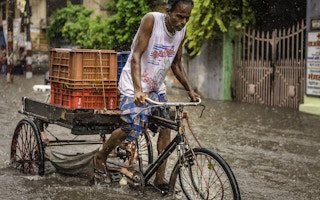In less than two weeks, world leaders will travel to New York for the U.N. secretary-general’s widely anticipated climate summit. On Sept. 23, they will have a unique opportunity to take stock of the latest warnings about climate change, and commit to work harder than ever to tackle rising emissions and growing climate impacts.
At the same time, governments meeting at the U.N. General Assembly will have a chance to review proposals for the post-2015 sustainable development framework. This framework, which follows on from the Millennium Development Goals, has been cooking for some time.
In July the Open Working Group, the taskforce responsible for drafting it, proposed 17 Sustainable Development Goals (SDGs) with 167 associated targets.
The burning question is: Do governments believe it is possible to achieve sustainable development without tackling climate change? The climate summit is their chance to show they’re serious about ensuring a sustainable planet for all.
International development agencies and green groups certainly think that delivering sustainable development and tackling climate change go hand in hand.
In a new report, “The right climate for development: Why the SDGs must act on climate change”, CARE International, Christian Aid, WWF, Greenpeace, CAFOD and Oxfam analyse the findings in the latest series of reports from the Intergovernmental Panel on Climate Change, and explain what the science means for people living in poverty.
This NGO report makes for sombre reading. It shows that climate change is fast becoming the greatest threat to tackling global poverty, affecting many aspects of development work and worsening existing gender inequality and other injustices. If the SDGs fail to respond to the reality of a rapidly warming world, they will ultimately fail, the report authors warn.
Positives
The good news is that certain governments have started to take note, as a new CARE paper explains. Although far from perfect, there are a number of positives in the latest draft of the SDGs.
First this draft includes a dedicated climate change goal, which commits governments to “take urgent action to combat climate change and its impacts” - the result of support from various governments and civil society groups. If the draft text is carried forward, this is a win.
Second, there has been broad consensus to integrate climate change across the SDGs, and a number of the SDG targets now contain explicit reference to climate-related aspects, such as resilience and disasters, or are clearly linked to climate change adaptation or mitigation. Targets related to poverty eradication, ending hunger, energy, and sustainable consumption and production are just a few examples.
Third, climate change has gained prominence in the introductory text of the SDG document. This introduction, a vital scene-setter for major global frameworks like this, now also contains clear references to the need to reduce emissions as a matter of urgency before 2020 and limit global warming to 2 or 1.5 degrees Celsius above pre-industrial levels. It could be further strengthened by including a commitment to phase out carbon pollution globally before the middle of the century.
Weaknesses
“
Weak on substance, ambition and with only a loose sense of when and how governments must take action, the latest draft has failed to heed the advice of countless proposals about how to beef up the targets. It also lacks any commitment to clear guiding principles for climate action, such as rights-based, gender-equitable and participatory approaches.
Despite this, the SDG negotiations and outcomes to date have not been all good.
For starters, the proposed climate change goal lacks teeth. Weak on substance, ambition and with only a loose sense of when and how governments must take action, the latest draft has failed to heed the advice of countless proposals about how to beef up the targets. It also lacks any commitment to clear guiding principles for climate action, such as rights-based, gender-equitable and participatory approaches.
The targets themselves are also relatively vague, with no sense of how they will be measured or a timeline for doing so. The urgent need to promote low-carbon development and cut emissions globally in a fair and equitable manner are also absent from the goal’s targets, despite clear scientific and political acknowledgement of their importance.
A demand from vulnerable nations, including Least Developed Countries, to include a target that limits global warming to 2 or 1.5 degrees was also moved to the introductory text following resistance from a number of countries.
Overall, there is a distinct lack of urgency. Take, for example, targets to expand renewable energy and energy efficiency. Rather than providing a real call to action, urging governments to scale up their investment in renewables, the draft text asks governments to “increase substantially the share of renewable energy in the global energy mix by 2030”.
This lags far behind what is actually needed globally and what it is possible to achieve. Proposals to phase out fossil fuel subsidies are also weak - the document simply refers to “rationalising inefficient fuel subsidies”.
Call for collaboration
The fact that there is a dedicated U.N. process on climate change under the UNFCCC has been used too often in the negotiations as an excuse not to include substantive, razor-sharp proposals both for a climate goal and climate targets under the SDG framework. But what’s needed is a spirit of collaboration and complementarity between the two processes, which exist to do different things.
Leaders meeting in New York must provide a clear signal that they will go further. They have an opportunity to highlight their commitments to act on climate change as the world looks on. Then it will be over to U.N. Secretary-General Ban Ki-moon to prepare his recommendations to states.
As the convenor of the U.N. Climate Summit, it seems only logical that Ban-Ki moon’s report will seek greater support for stronger climate action in the SDGs.
Then it will be up to governments to get back to the negotiating table, probably early next year, to tweak and polish the sustainable development framework and turn it into a truly transformative, visionary and accountable agenda for the future, based on ambitious and effective climate action.
Substantial financial support from developed countries and other better-off nations must be part of the overall package. The final agreement, due in September 2015, can and must set the scene for a landmark global climate change deal.
We cannot deliver sustainable development without tackling climate change, and we cannot tackle climate change without addressing the root causes of poverty. An integrated approach is needed, and needed now.
Sven Harmeling is the climate change advocacy coordinator at CARE International. This post originally appeared on Thomson Reuters Foundation’s Alertnet.











